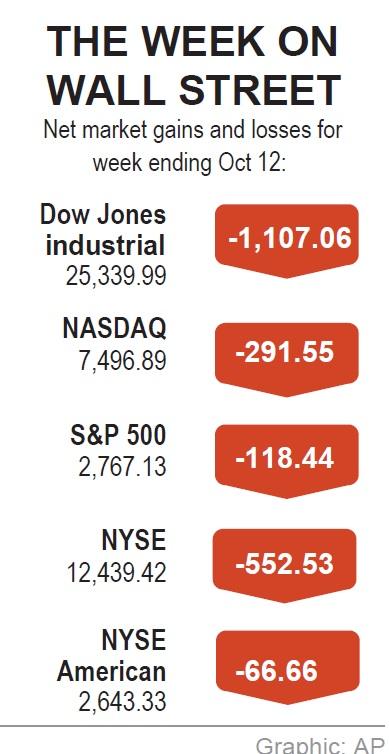The US benchmark S&P 500 stock index on Friday snapped a six-day losing streak as technology stocks recovered after a week of losses, with investors looking for bargains ahead of the third-quarter earnings reporting season.
Even the hard-hit S&P 500 energy and financial sectors managed to close the session with slight gains after a late afternoon rally.
The S&P technology index gained 3.2 percent on the day, showing its strongest one-day gain since March 26, although it still registered its biggest weekly drop since March 23.

“People are starting to buy in, thinking the higher flying growth stocks were oversold. They wanted to get in before next week when earnings start coming,” said Janna Sampson, co-chief investment officer at OakBrook Investments LLC in Lisle, Illinois.
However, until the US and China reach a trade deal, the rebound in the stock market could be vulnerable as investors are anxious about the impact of tariffs on corporate profits.
“If earnings come out good I think this rally is sustainable if we don’t get negative trade news. Trade news is the wild card. That’s the big if,” Sampson said.
The Dow Jones Industrial Average rose 287.16 points, or 1.15 percent, to 25,339.99, the S&P 500 gained 38.76 points, or 1.42 percent, to 2,767.13 and the NASDAQ Composite added 167.83 points, or 2.29 percent, to 7,496.89.
For the week, the Dow lost 4.19 percent, the S&P fell 4.1 percent and the NASDAQ shed 3.74 percent.
The technology sector’s biggest boosts were Apple Inc and Microsoft Corp, which rose more than 3 percent, while Visa Inc and Mastercard Inc climbed almost 5 percent, boosted by strong credit card sales included in bank earnings reports, Sampson said.
The S&P500’s financial sector ended the day up 0.1 percent and the S&P 500 banks sub-sector closed down 0.4 percent, well above its session low. The biggest drag on the sub-sector was JPMorgan Chase & Co, which closed down 1.0 percent, despite reporting a quarterly profit that beat expectations.
PNC Financial led the percentage losers among bank stocks, with a 5.6 percent drop after the regional bank reported disappointing quarterly loan growth and said it expected only a small improvement in lending this quarter.
The three gainers among banks included Citigroup Inc, which rose 2 percent, and Wells Fargo, which eked out a 1.3 percent gain after upbeat results.
Netflix and Amazon Inc, some of the names that took a big hits in the week’s sell-off, rose 5.7 percent and and 4.0 percent respectively.
The bank results launch a quarterly reporting season that will give the clearest picture yet of the effect on profits from US President Donald Trump’s trade war with China.
Earnings at S&P 500 companies are estimated to have risen 21.5 percent in the third quarter, I/B/E/S data from Refinitiv showed, a slowdown from the previous two quarters.
Energy stocks ended the day up 0.3 percent as oil prices steadied to settle up slightly after a volatile session dropped on a weakening oil demand outlook.
The consumer discretionary and communication services sectors, both rose more than 2 percent.
Advancing issues outnumbered declining ones on the NYSE by a 1.38-to-1 ratio; on NASDAQ a 1.51-to-1 ratio favored advancers.
The S&P 500 index posted no new 52-week highs and 52 new lows; the NASDAQ Composite recorded 10 new highs and 234 new lows.
Volume on US exchanges was 8.91 billion shares, well above the 7.78 billion average for the past 20 trading days, but below the soaring volume of Thursday’s and Wednesday’s sessions.

To many, Tatu City on the outskirts of Nairobi looks like a success. The first city entirely built by a private company to be operational in east Africa, with about 25,000 people living and working there, it accounts for about two-thirds of all foreign investment in Kenya. Its low-tax status has attracted more than 100 businesses including Heineken, coffee brand Dormans, and the biggest call-center and cold-chain transport firms in the region. However, to some local politicians, Tatu City has looked more like a target for extortion. A parade of governors have demanded land worth millions of dollars in exchange

Hong Kong authorities ramped up sales of the local dollar as the greenback’s slide threatened the foreign-exchange peg. The Hong Kong Monetary Authority (HKMA) sold a record HK$60.5 billion (US$7.8 billion) of the city’s currency, according to an alert sent on its Bloomberg page yesterday in Asia, after it tested the upper end of its trading band. That added to the HK$56.1 billion of sales versus the greenback since Friday. The rapid intervention signals efforts from the city’s authorities to limit the local currency’s moves within its HK$7.75 to HK$7.85 per US dollar trading band. Heavy sales of the local dollar by

Taiwan Semiconductor Manufacturing Co’s (TSMC, 台積電) revenue jumped 48 percent last month, underscoring how electronics firms scrambled to acquire essential components before global tariffs took effect. The main chipmaker for Apple Inc and Nvidia Corp reported monthly sales of NT$349.6 billion (US$11.6 billion). That compares with the average analysts’ estimate for a 38 percent rise in second-quarter revenue. US President Donald Trump’s trade war is prompting economists to retool GDP forecasts worldwide, casting doubt over the outlook for everything from iPhone demand to computing and datacenter construction. However, TSMC — a barometer for global tech spending given its central role in the

The Financial Supervisory Commission (FSC) yesterday met with some of the nation’s largest insurance companies as a skyrocketing New Taiwan dollar piles pressure on their hundreds of billions of dollars in US bond investments. The commission has asked some life insurance firms, among the biggest Asian holders of US debt, to discuss how the rapidly strengthening NT dollar has impacted their operations, people familiar with the matter said. The meeting took place as the NT dollar jumped as much as 5 percent yesterday, its biggest intraday gain in more than three decades. The local currency surged as exporters rushed to